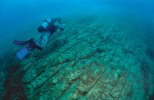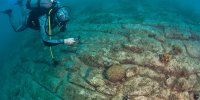BIBLIOGRAPHY
Campbell, Hamish, et al., "To sink a continent: Exploring the implications of Zealandia's fate," GNS Science, New Zealand, 2008.
Cifelli, Richard, "Age relationships of Mid-Atlantic Ridge sediments," Special Paper No. 124, Geological Society of America, 1970.
Davies, Nigel, "Voyages to the New World," William Morrow and Co., Inc., New York, 1979.
de Camp, L. Sprague, "Lost Continents," Dover Publications Inc., New York, 1970.
Ewing, Maurice, "Exploring the Mid-Atlantic Ridge," The National Geographic Magazine, Vol. xciv, No. 3, September 1948.
Ewing, Maurice, "New Discoveries on the Mid-Atlantic Ridge," The National Geographic Magazine, Vol. xcvi, No. 5, November 1949.
Ewing, W.M.; Dorman, H.J.; Ericson, J.N. & Heezen, B.C., "Exploration of the northwest Atlantic mid-ocean canyon," Bulletin No. 64 of the Geological Society of America, 1953.
Heezen, B.C., Tharp, M., Ewing, M., The North Atlantic, Washington D.C., 1959.
Kolbe, R. W., "Fresh-Water Diatoms from Atlantic Deep-Sea Sediments," Science, Vol. 126, No. 3282, 22 November, 1957.
Kolbe, R. W., "Turbidity Currents and Displaced Fresh-Water Diatoms," Science, Vol. 127. No. 3313, 27 June 1958.
Leonard, R. Cedric, A Geological Study of the Mid-Atlantic Ridge, Special Paper No. 1, Cowan Publ., Bethany, 1979.
Leonard, R. Cedric, "Quest for Atlantis," Manor Books Inc., New York, 1979.
Longwell, Flint & Sanders, "Physical Geology," John Wiley & Sons, Inc., New York, London, Sydney, 1969.
Malaise, Rene, Sjunket l and i Atlanten, Ymer, Stockholm, 1956. (See also his Atlantis en Geologisk Verklighet, Bibliofilupplaga, Stockholm, 1951.)
Mellis, Otto, Zur Sedimentation in Der Romanche-Tiefe (Ein Beitrag zur Erklarung der Enstellung des Tiefseesandes in Atlantischen Ozean), Geologischen Rundschau, Goteborg, 1958.
Miller, J. P. & Scholten, R., "Ocean, Lakes, and Shoreline Features," Labratory Studies in Geology, No. 225, 1966.
Nansen, Fridtjof, "The Norwegian North polar expedition, 1893-1896: scientific results," Longmans, Green & Co., London New York, 1900-1903.
Pettersson, Hans, Atlantis och Atlanten, Albert Bonniers förlag, Stockholm, 1944.
Pettersson, Hans, "A Swedish deep-sea expedition," Communication by Sir John Edgell, F.R.S., received 18 February 1946.
Pettersson, Hans, "A Swedish deep-sea expedition," Proceedings of the Royal Society of London (Series B), Biological Sciences, Vol. 134, No. 876, 2 Jul 1947.
Pettersson, Hans, "Exploring the Ocean Floor," Scientific American magazine, August 1950.
Piggot, Charles S., "Core samples of the ocean bottom," Carnegie Institution of Washington News Service Bulletin Staff Edition, 4 (no. 9), 6 December 1936.
Piggot, Charles S., "Core samples of the ocean bottom," Smithsonian Report for 1936, No. 944, Smithsonian Institution, Washington DC, pp. 207-16, 1937.
Sclater, John G., & Tapscott, Christopher, "The History of the Atlantic," Scientific American, Vol. 240, No. 6, June 1979.
Speicher, John, "Plate Tectonics—A Startling New View of Our Turbulent Earth," Popular Science, Vol. 200, No. 6, June 1972.
Tolstoy, I. & Ewing, M., "North Atlantic hydrography and the Mid-Atlantic Ridge," Bulletin of the Geological Society of America, Vol. 60, No. 10, October 1949.
Zhirkov, N. H., as he reports in his book "Atlantida" (English edition, p. 282), Moscow, 1958.






